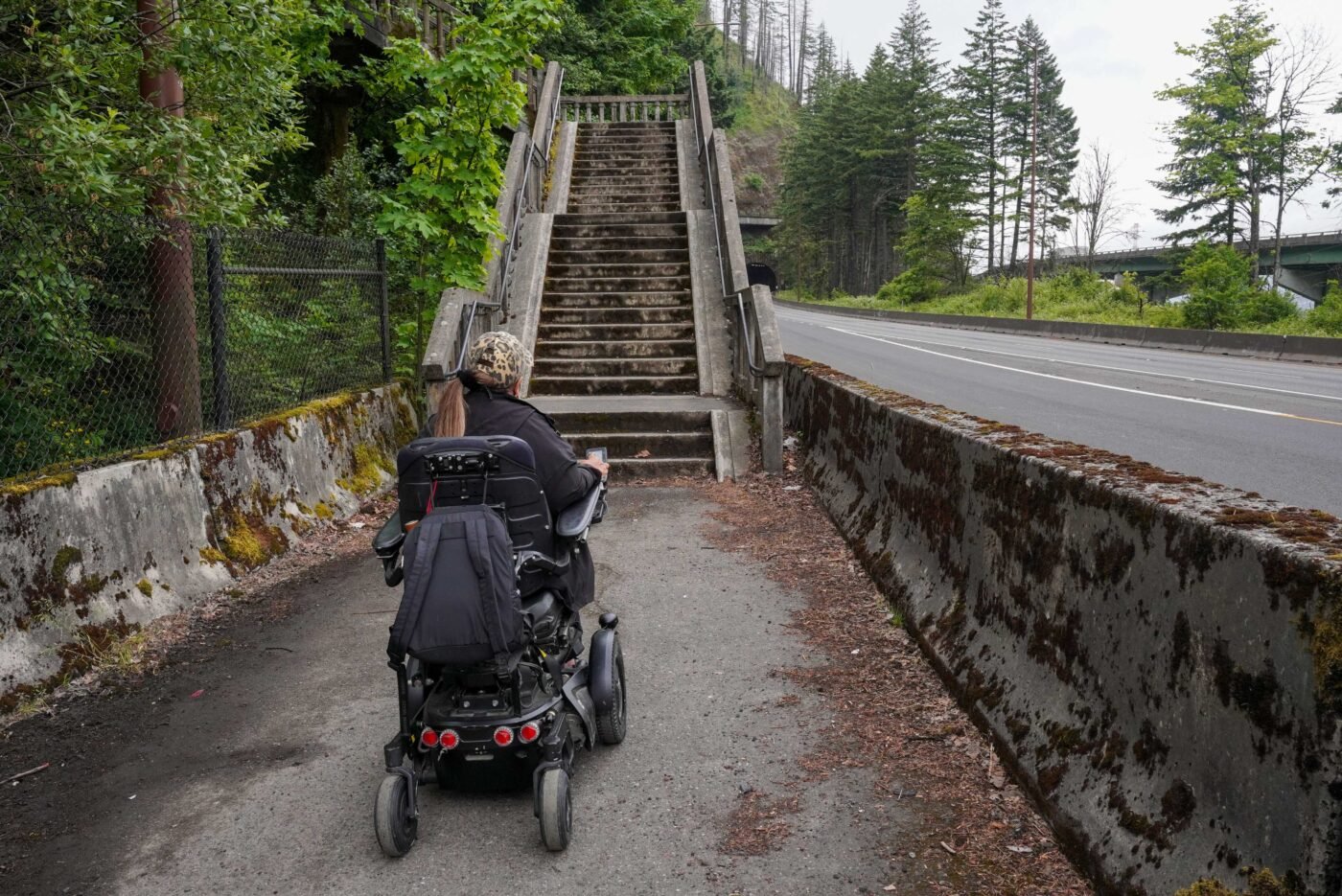
There are few tools left for advocates to create urgency around the need to replace a set of inaccessible stairs near the Eagle Creek Trailhead on the Historic Columbia River Highway State Trail. They’ve gotten the issue squarely on the radar of the Oregon Department of Transportation and they’ve filed lawsuits and staged protests.
Their latest effort? Tour the site with a nationally-known disability rights advocate and make sure a journalist is there to cover it.
Last Friday I drove to the Eagle Creek Trailhead about 40 miles east of Portland in the Gorge to meet former Ms. Wheelchair America and Board Member of the Rails to Trails Conservancy, Juliette Rizzo. Rizzo, 55, has progressive disabilities caused by a mosquito bite that led to an infection when she was three years old. Rizzo learned the ropes of accessibility advocacy while working as communications director for Judith Heumann, a woman many people consider the mother of the disability rights movement.
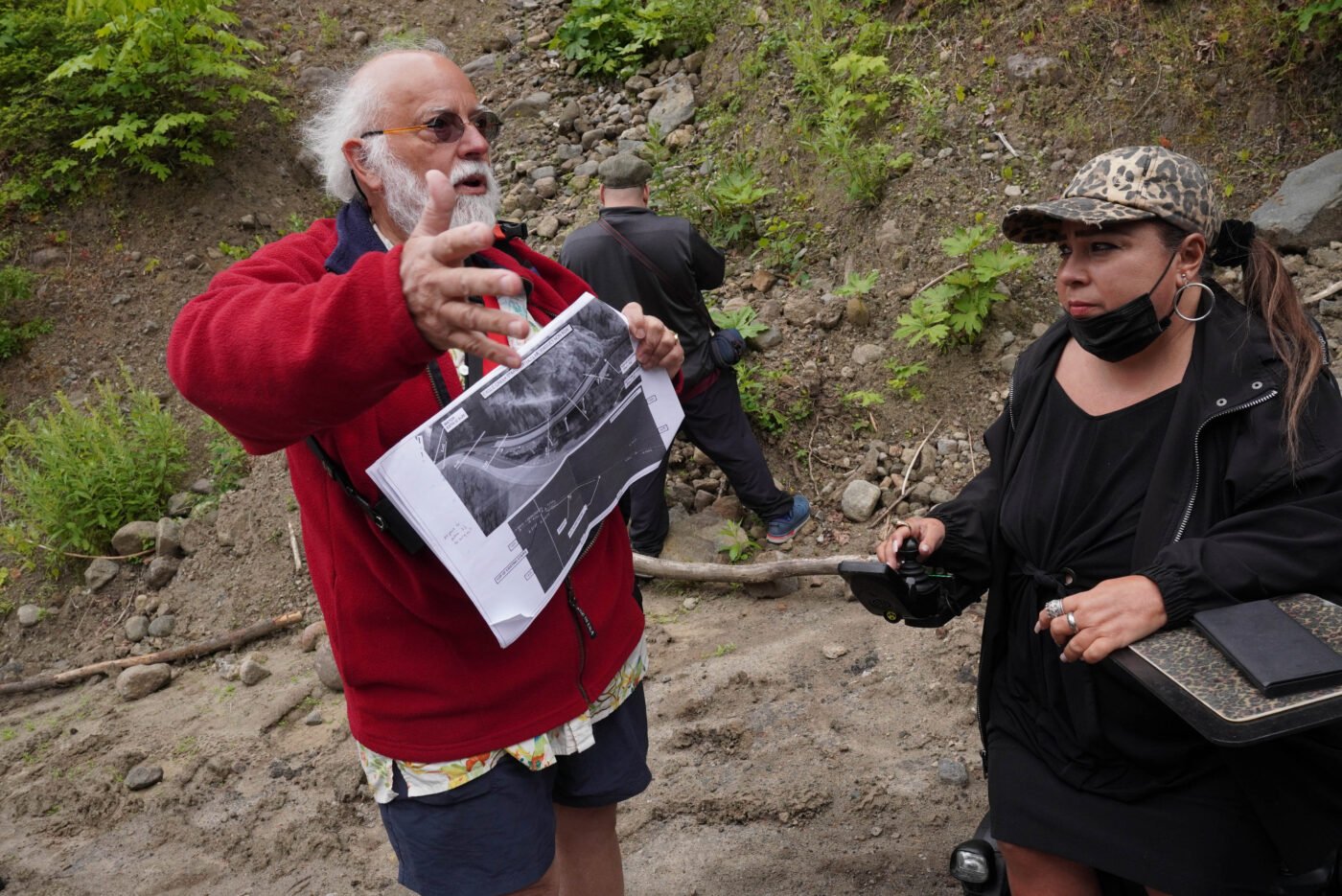
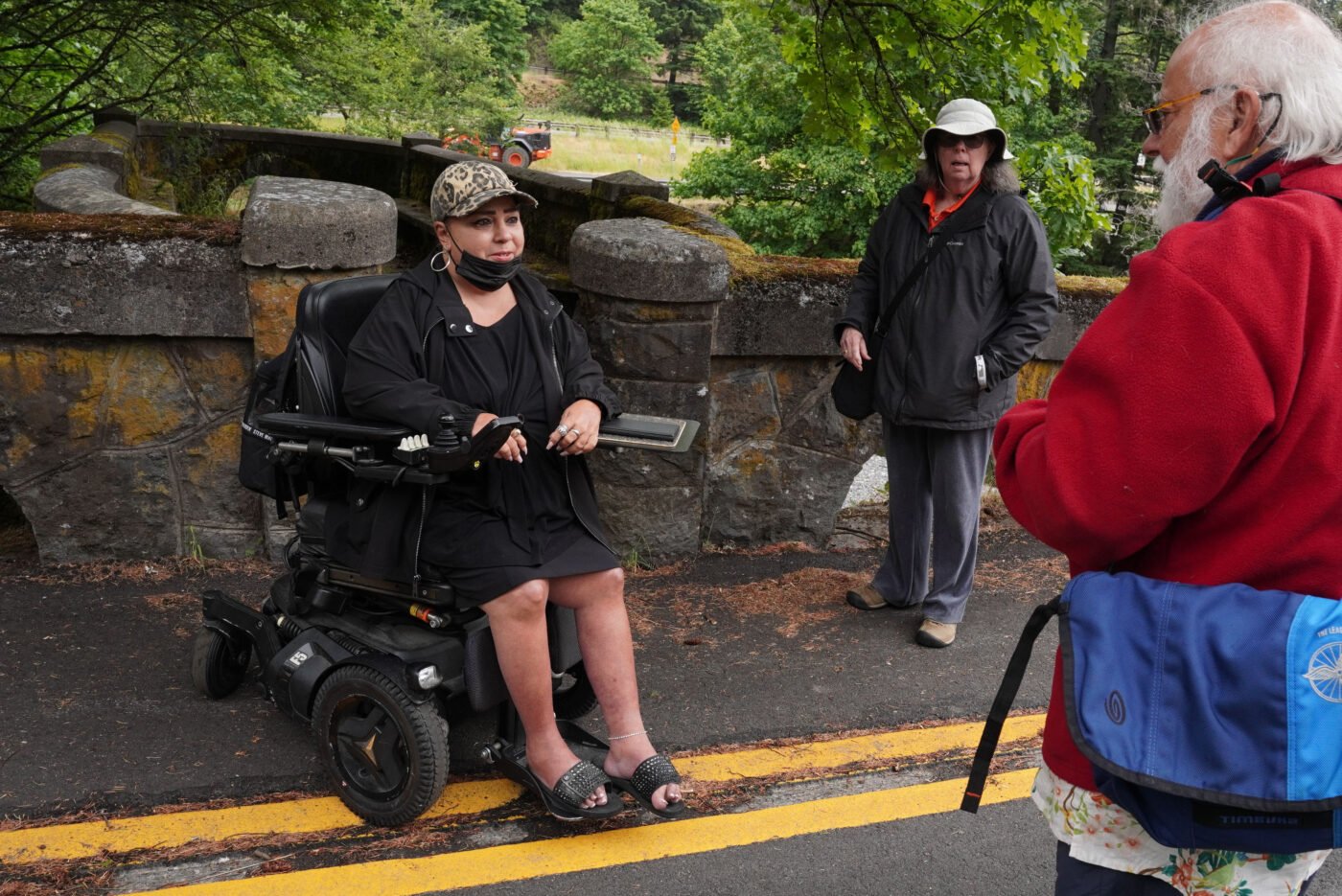

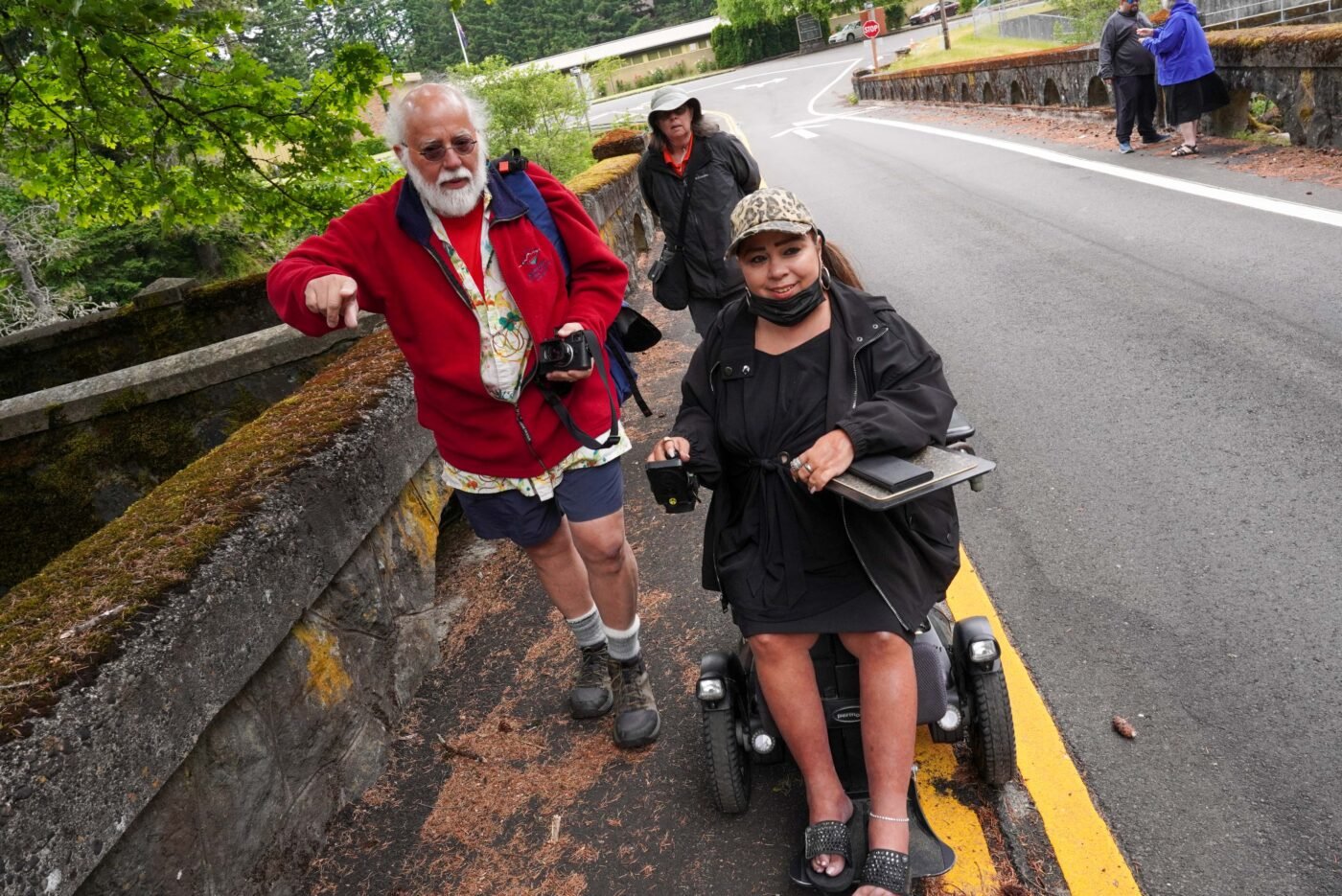

Rizzo was invited to the Gorge by AJ “Jerry” Zelada, a longtime Oregon cycling advocate who’s teamed up with Rizzo to broaden awareness of disability access issues to cycling and walking advocates (he’s also a board member of the Friends of the Historic Columbia River Highway and former chair the Oregon Bicycle and Pedestrian Advisory Committee). The duo has presented together at Walk Bike Places and the League of American Bicyclists National Bike Summit. Rizzo has also been a keynote speaker at America Walks and the 2018 Utah Department of Transportation Pedestrian Summit.
Now Zelada hopes Rizzo’s star power can help move the needle and finally replace this staircase once and for all.
Located about two miles west of Cascade Locks right off exit 41 and built in 1996 (six years after the Americans with Disabilities Act was passed), Zelada describes the stairs as a “tourniquet” that cuts off many people from enjoying the state trail. He thinks now is the right time to build an ADA-compliant ramp so that everyone can experience the state trail as ODOT creeps ever closer to fully connecting the 73-mile project between Troutdale and The Dalles. “The urgency is really the fact that the Mitchell Point tunnel is coming online in the second quarter of 2024,” he shared with me Friday. When the trail project is done, it will garner major headlines and attract thousands of tourists to Oregon to experience it.
But unless ODOT and their partners do something soon, the imposing and impassable staircase will still be there.
To Zelada, the issue goes beyond people who use wheelchairs and other mobility devices. He and Rizzo talk about “cross disabilities” — less visible conditions like cognitive, vision, sensory, hearing, and many other issues. Or even people who are older and/or recovering from injuries or medical treatments. Then there are the bike riders or people with strollers who simply cannot lift their bikes down the multiple flights of steep stairs. Imagine if you have a stroller with very small children and you have to make two trips, Zelada said. What happens to the kids while you set them down and make the second trip to get the stroller?
“A ‘cure’ for me is staying active, to lessen my rigidity and strengthen my immune system with fresh air… it’s also critical that I don’t run into barriers.”
– Juliette Rizzo
The Eagle Creek Trailhead, where we met on Friday, is one of the most ADA accessible parking lots in the Gorge. It’s relatively flat and has large parking spots for specially-equipped vans. It’s also one of the closest major trail access point to the Portland metro area.
As Rizzo and the rest of the group made their way to the stairs, we used the bike lanes between the parking lot and the trail. When we came upon an old lookout over the creek with a stone wall and bench in the middle, we realized its entry was too narrow for Rizzo’s chair. “So that was fun,” Rizzo said, sarcastically. “How awesome that would be and how easy that would be to make that accessible?”
For Rizzo, having experiences in nature are key to her health. “A ‘cure’ for me is staying active, to lessen my rigidity and strengthen my immune system with fresh air. It’s critical to me,” she told me. “And it’s also critical that I don’t run into barriers in the great outdoors.”
“There are many people that say, ‘Oh, well, she’s bound by a wheelchair.’ But what I say is, how can I be bound by the only thing that brings me freedom?”
But Rizzo wasn’t free to enjoy this trail. As we approached the staircase, she pointed out that there wasn’t even a sign from the parking lot saying that the trail was inaccessible to people in wheelchairs or with other physical disabilities. She then rolled right up to the base of the stairs, while others continued up them. Her friend walked all the way to the top to explore the forest where the path begins. With her head tilted up into the trees beyond the stairs, she said, “I just can’t join my friends.”
ODOT says they want people like Rizzo to be able to enjoy the full trail, but fixing the stairs just isn’t a top priority right now. ODOT’s Columbia River Gorge National Scenic Area Coordinator Terra Lingley shared in an email with BikePortland this morning that her office (working with the Oregon Trails Coalition) sent a “congressionally directed spending” (aka earmark) request to Congressman Earl Blumenauer’s office this earlier this year. “The package included a request for funding for alternatives analysis to understand the range of ADA-compliant solutions to address the Eagle Creek Stairs,” Lingley wrote. “These stairs remain on our priority list, but our first priority is to create the full connection of the [state trail].”
It’s a complicated project. The first issue is cost, which goes up every year. Then there are the technical and geological challenges.
In 2009 a project to replace the stairs with a ramp was estimated (very roughly) at $2.5 million. In spring 2022, an estimate from an engineering firm put the cost at $40 million (about the cost of the damage from the devastating 2017 Eagle Creek wildfire). Now Zelada says it’s up to $50 million.
“ODOT is out there, looking for money to do the project,” Zelada shared with me Friday as we walked back to the parking lot. “But they say in terms of an ADA priority, this is at the end of the line after many other projects and have given us a 2030 completion estimate.” ODOT has also said that they are prioritizing completion of the state trail before the stairway project.
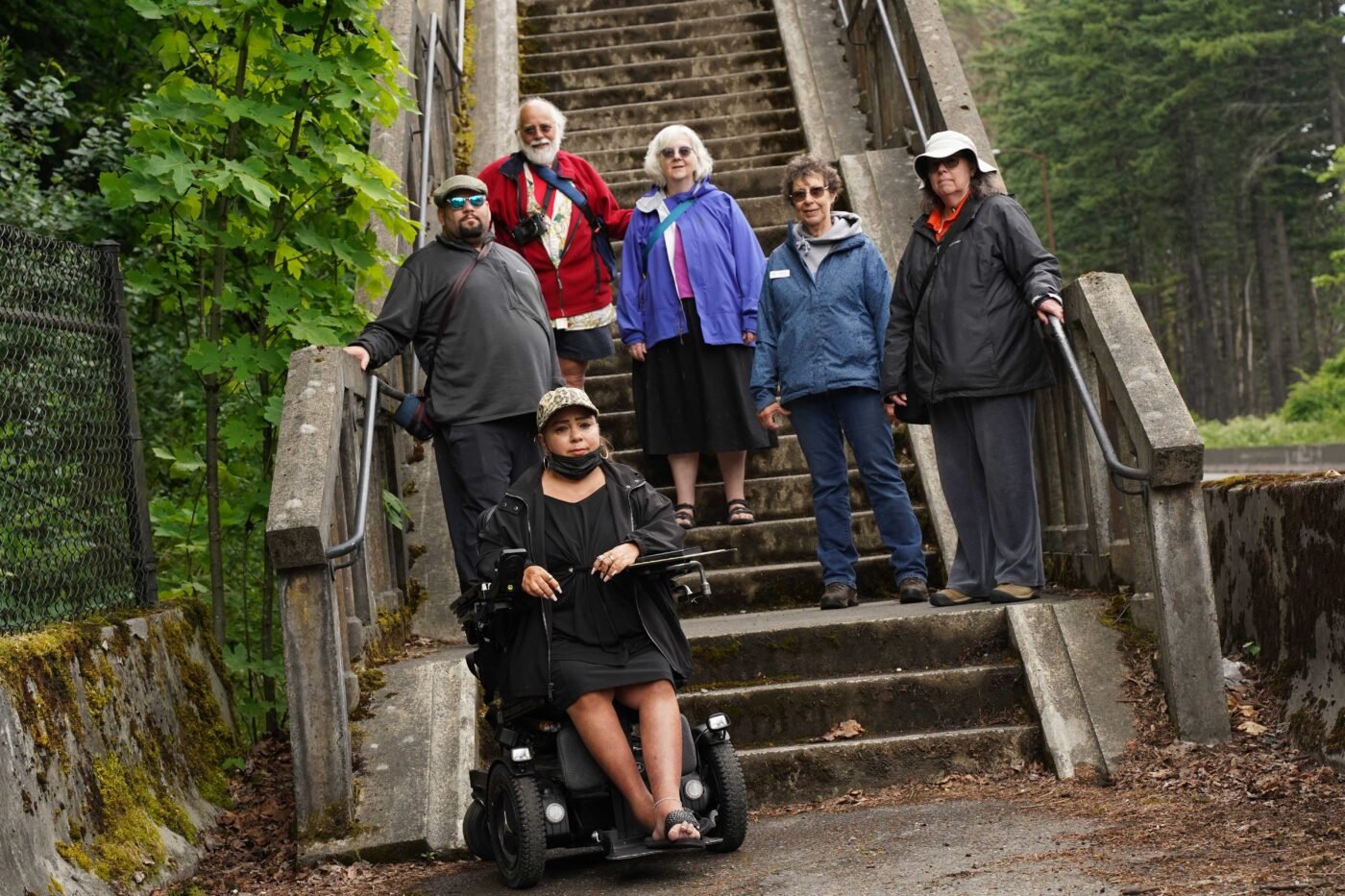
Costs aside, Zelada understands the complexity of building an ADA-compliant ramp on a steep slope is no small task — especially given the type of soils in the Gorge. “We’re under a riverbed right now,” he said, referring to the Missoula Floods that carved the Gorge thousands of years ago. “The earth out here is basalt with a sandy slope and is very unstable. You can’t fix a trail to it. The solution isn’t just getting rid of the staircase, it’s finding a solution within this living geology we are standing on.”
Despite the challenges, Rizzo seemed optimistic after her visit. “Many people think it’s about physical accessibility. But sometimes the most important things are accessible attitudes. With accessible attitudes, anything is possible,” she said. “It is just a matter of getting the right people at the right table at the right time to make this happen.”
Then in her typical wit, Rizzo added, “And you know, it would be easy to have me at your table because I bring my own chair.”
Here’s to hoping we can all roll on this trail with Rizzo when she returns to Eagle Creek in the coming years.


